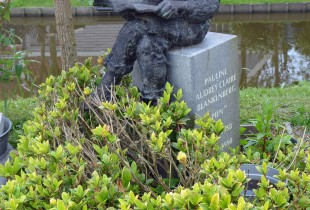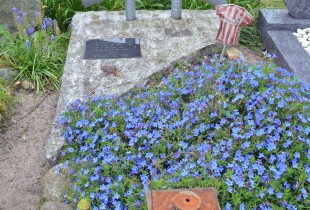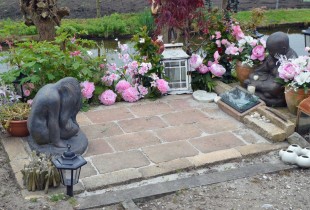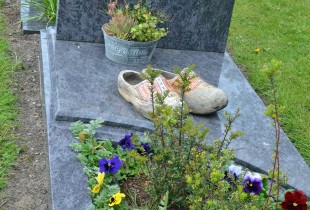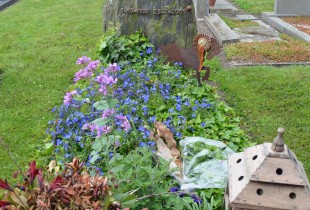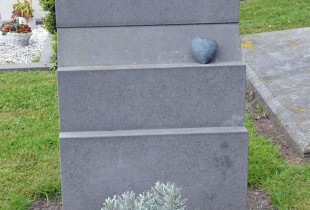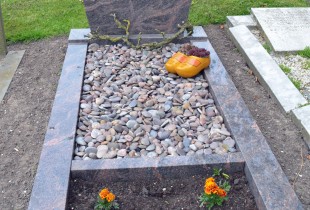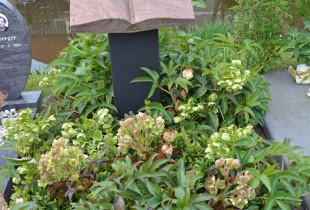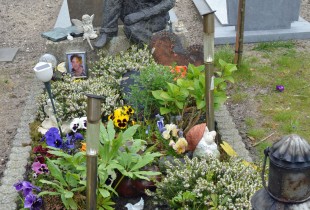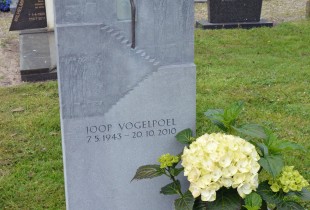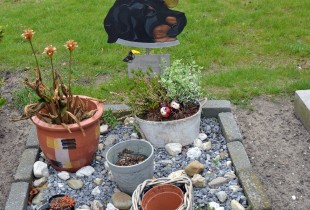De Beemster – On Our Own in a World Heritage Site
In my last post on the bike and barge trip to Holland with Cycletours we pedalled to the North Sea and through the magnificent sand dunes that abut the shore before spending the night at the lovely little city of Alkmaar. Today Alison and I are going to try for something completely different in De Beemster, a UNESCO World Heritage Site. Please join us.
For some reason it never occurred to me that Alison and I could just strike out on our own at any time we pleased. At the beginning of the trip our guide Albert gave us all a booklet with detailed maps of each day’s route. I am a pretty fair map reader so I had no concerns about getting lost and even if we did we had Albert and Marije’s cell numbers. Yesterday we came across a couple from one of the other Cycletours groups who were obviously not with the group and they said that they traveled on their own every day. I asked Albert if we could do the same for today and he said, “Sure” – so it’s Holland solo today in De Beemster.
Writing this after the end of the day I can say without reservation that it was the most enjoyable day of the trip – not because we were on our own, but because we had no timetable or designated route other than to meet the Zwaan at Purmerend at the end of the day. There was a genuine freedom to explore and that’s what to me is the essence of traveling. After breakfast we followed the group sans the now boat bound Brigitte out of Alkmaar into the open polder country of North Holland. We split from the group just after crossing under the very busy N242 highway. The cycling today was almost entirely along dykes that had a canal on one side. The countryside was mostly pastureland with a few surprises such as these bulb fields that were being inspected by, I presume, the farmers who owned them.

There were very few towns, but many fine farmhouses of the style known as pyramid houses because of their shape. Here are three examples. The first is an older house with a thatched roof which was probably several hundred years old dating back to the when the polder was first drained and ready for settlement. Older pyramid houses often sheltered more than one family due to the large size or more commonly also contained the barn.
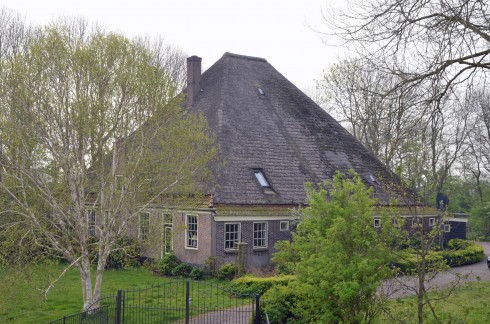
While the pyramidal houses may have lost their raison d’etre with most families not wanting to share their space with others, let alone livestock, the style continues to be popular in this area even for new construction as in the house below. Note how the house is fenced in to keep the sheep out and not the other way around.
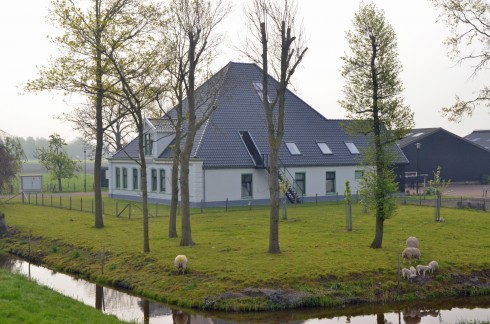
We also saw a number of houses that combined the old and new pyramidal roof design in one building, as below. This picture also contains a feature that is very common in both Dutch city and country houses – the use of espalier to control the growth of shrubs and small trees so that when covered in leaves they provide shade to the interior of the house. I first noticed this in Haarlem and Albert gave me the aforementioned reasoning behind it, although I have to admit I was skeptical at first. However, after almost a week in Holland I am convinced. I’m not sure I would want to block the view in exchange for shade when I could just pull the curtains or in this case, close the shutters, but the Dutch do.
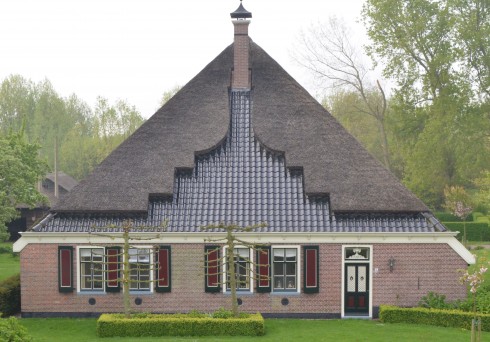
This area of North Holland province is still very wet in places and there were so many windmills in active use that we gave up counting them.
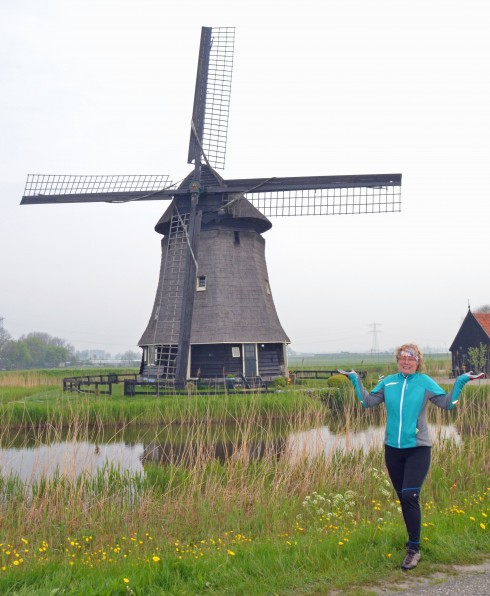
Every windmill is occupied by the keeper’s family and it was interesting to see that wooden shoes are still in use by these families. I noticed that a number of the windmills had places for people to hang up their shoes outside the front door.
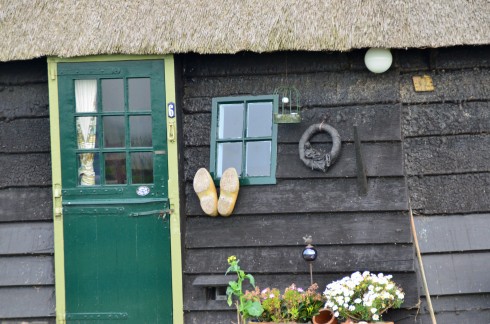
The more we cycled that morning and and saw things like the wooden shoes by the door, the more enchanting everything seemed. There where lambs frolicking in almost every field.
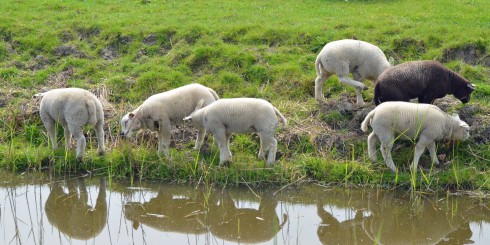
Tiny horses.
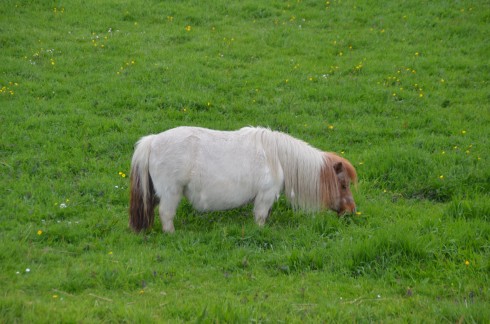
I began to slip into a reverie and could easily have convinced myself that I had somehow entered a fairy tale land or maybe even Middle Earth. It would not have surprised me one bit to see a Hobbitt emerge from one of the windmills and saddle up the miniature horse.
We came to the small town of Ursem and rather than cycle on by we crossed the canal and took a short tour of this ultra tidy and ultra pretty little place. While there were a number of very interesting houses this one caught my eye. Note the clothes on the line. Normally I would not put this in the picture but Liz told me her hobby was painting clotheslines with washing on them. So this picture is for Liz and I hope she can blow it up and make a painting of this wonderful house in Ursem.
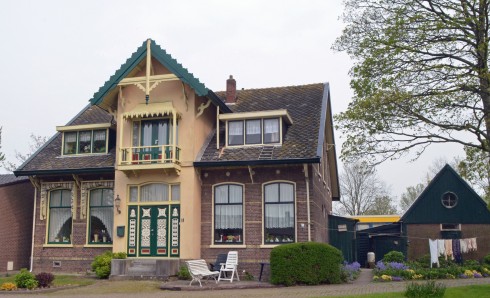
Not far from Ursem was the even smaller town of Schermerhorn. As we approached it we noticed that many of the farms had unusual sculptures in their yards. Just outside the town we saw the familiar yellow Cycletours saddle bags and realized the rest of our group was having a planned stop at the studio of the late sculptor Nic Jonk. It was his works we had been seeing and continued to see for many miles past Schermerhorn. We opted not to visit the studio (what was I going to do with a piece of large Dutch sculpture?) and headed to the small crossroads at the centre of the village where there was the traditional weigh house and a large church. The weigh house dated from the 1500’s and Schermerhorn must have been a very different place then, much closer to the ocean and certainly more directly in the lanes of commerce to have a building of this size and status. I think the grounded boat filled with flowers in the foreground must be symbolic of Schermerhorn’s transition from a sea based economy to that of the land.
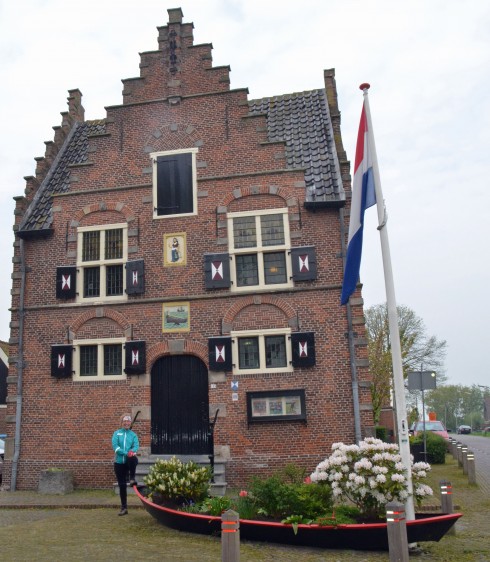
Attached to the weigh house was, I guessed, the Court House because it had this rather pudgy lady holding up the scales of justice. Justice is apparently not only blind in Holland, but a bit rotund as well.
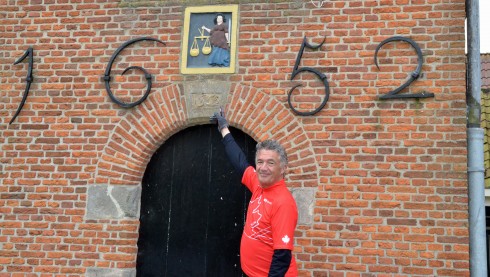
Across the street was a large church with a graveyard beside it. I am not sure where my fascination with graveyards came from, but I’ve had it for as long as I can remember and even included a chapter on historic Nova Scotia cemeteries in Exploring Nova Scotia. We had tried to get into an old cemetery in Leiden, but the gate was locked. The one here was open so we went in and had a revelation. The Schermerhorn cemetery is probably the most interesting I have visited in many a day. First of all, it was not old. The graves were mostly 20th century. Secondly it was quite small, not more than maybe 90 graves in total. Thirdly, and by far the most important characteristic, every grave was completely unique to the individual and comprised a monument to the deceased that painted a picture of who they were without ever having known the person. To me they comprised a collective work of art that will always make memories of Schermerhorn stand out in my mind.
The very first grave we saw was that of Nic Jonk which had one of his sculptures as the defining element. It seemed a bit strange that the rest of the group was right now at his former studio looking at his works for possible purchase and here we were, not that far away, looking at his grave.
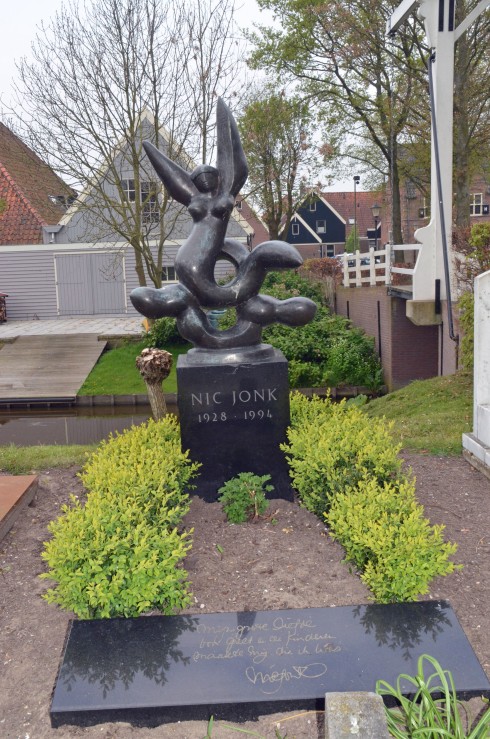
Almost every grave had real plants growing it – no faded cut roses, no God-awful plastic flowers – just the real thing; which meant someone was tending them and thus keeping in touch with their loved one. Many had small sculptures, while others had something that identified the deceased’ career. Only one had any obvious religious reference. These graves were about the people buried in them and not about some ‘higher power’ or some ‘new beginning’. I plan to be cremated, but if someone were to build me a personal monument like these after I die, I think it would an honour.
I have created a gallery of photos of the most unique of these graves which you can click on below. Click a second time to enlarge.
One final thing about Schermerhorn, and Ursem for that matter – they are totally off the beaten tourist path. I could find no information or pictures of the weigh house, the church or the cemetery on the internet. Despite their allure they manage to remain hidden gems and the only reason I discovered their charms is because we decided to explore on our own.
Leaving Schermerhorn I must confess to taking a wrong turn, but when I realized it I could tell from the map that it was no big deal as we would just end up in De Rijp, the next town, by a different route. As it turned out this new route took us through an even more off the beaten path place than Schermerhorn. Grootschermer is a tiny hamlet that can only be reached by one lane roads that run atop the dikes. The only commercial building I saw was an intriguing looking pub. These yellow roses were growing in front of one of the few houses in the place.
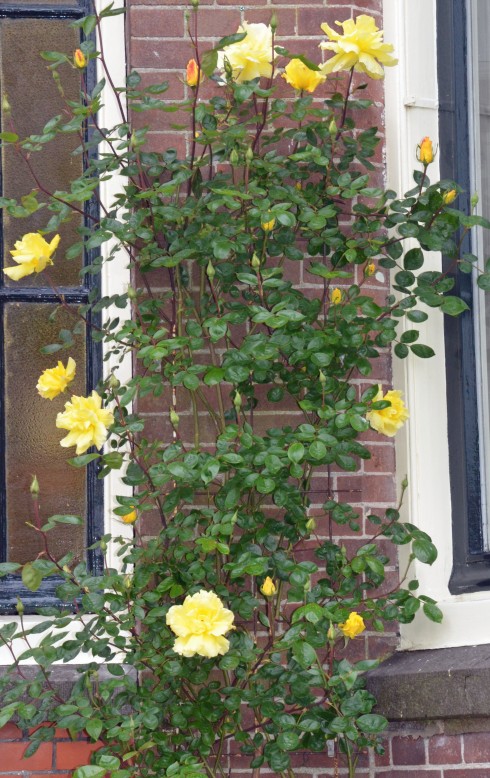
When you learn that De Rijp claims to have been a whaling port and centre of the herring fishing industry you might be tempted to say “Yeah, sure”. The ocean is miles away from the town and none of the canals are big enough to handle large ships, so what’s with the b.s.? Turns out De Rijp is probably one of the best examples of how certain communities benefited from the creation of the polders and others which lost access to the open ocean, had to adapt or die. From the looks of it De Rijp did a pretty job of adapting as it has all the hallmarks of prosperity. Entering the town we notice that preparations for Koningsdag, which is just two days away, are in full swing. Many of the buildings have some type of orange decorations and there is a festive atmosphere throughout the town.
Like Schermerhorn, at the centre of De Rijp is the weigh house and like Schermerhorn it has probably been centuries since any sea borne produce was weighed here.
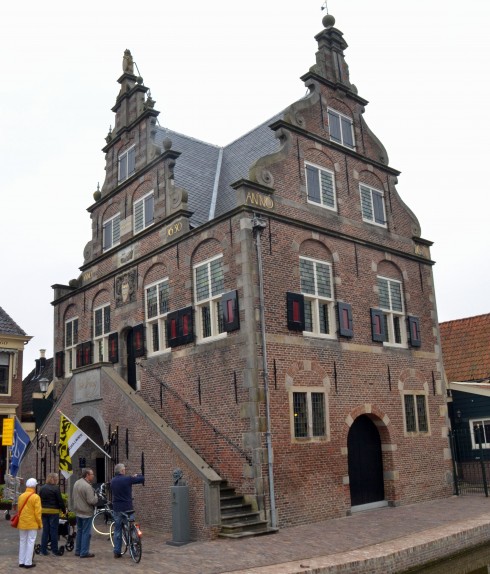
Next to it is the Stadhuis or townhall which has this very interesting coat-of-arms.
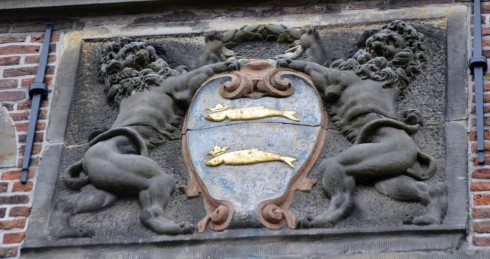
We caught up to the rest of the group who were eating their sandwiches at a restaurant across from the weigh house and joined them. No sandwiches for us today, even by accident. We ordered soup and salad, because in Dutch that’s soep and salade. Even I couldn’t screw the meaning of that up.
I had mentioned the interesting cemetery at Schermerhorn to Liza and Emma and noted that there was one across the street from the restaurant. We checked it out and it did have some interesting graves, including the one of a man and his dog, but there was nowhere near the integral unity of the Schermerhorn cemetery.
De Beemster
I had studied the map book and determined that we were going to take a completely different route from that the rest of the group would take that afternoon. I consulted with Albert and he approved. What I wanted to cycle through was De Beemster, a UNESCO World Heritage Site that is a monument to straight lines. De Beemster was the first massive experiment in creating land by draining lakes in North Holland. It was the brainchild of one man, Jan Leeghwater, who foresaw huge profits from creating land in a country desperate for it. Once the lakes were drained it remained only to set out roads and towns. Since the land was perfectly flat with no recognizable landmarks it made sense to do it all in straight lines – why make a turn when you don’t need to?
We left De Rijp and headed into De Beemster. It is well below sea level and fairly wet. I watched this black-tailed godwit as it searched for food in this green meadow and it dawned on me that this word ‘meadow’ which has only pleasant connotations, is absolutely perfect to describe the countryside of De Beemster.
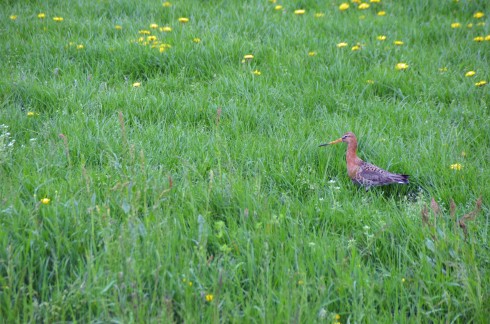
De Beemster is famous for more than straight lines; they also make a wicked cheese which is quite different than the gouda I have been describing. I tried it with my lunch at Egmond aan Zee and it has a flavour and texture closer to cheddar than gouda. On our way to Middenbeemster with cycled past a huge cheese factory with a spotted blue cow outside, which is the mascot for the cheese. Here is a shot of the bike path to Middenbeemster – talk about a vanishing point!
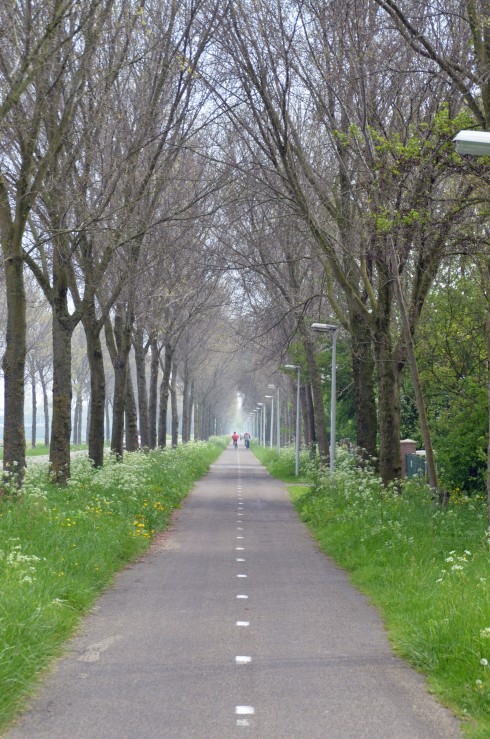
From Middenbeemster we turned south and picked up the path that runs along the canal that marks the south side of De Beemster and were soon in Purmerend where we found the Zwaan without any difficulty. We got there about three and it was another two hours before Albert and company showed up. I have no idea what they were doing that took so long, it may simply be that traveling on our own we cycled a lot faster than the guided group. In any event it was one of the best days of cycling I can remember, anywhere.
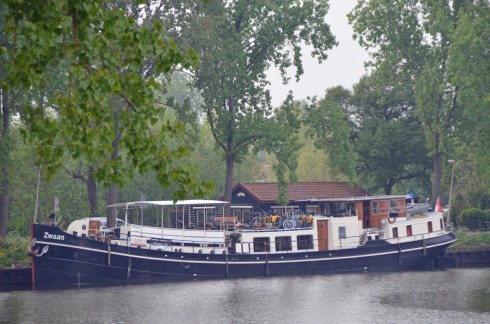
That night Dorus was going to provide us with that ‘traditional’ Dutch meal I had been looking for since arriving in Holland. It was preceded by a glass of Jenever provided courtesy of Albert. Years ago I had bought a bottle of this stuff thinking that because it was gin it must be like Beefeater or Tanqueray – wrong! It tasted somewhere between a really bad grappa and battery acid. So, it was with a little trepidation that I took my first sip of Albert’s offering, however, this was not too bad all things considered. Just to make sure Albert’s feelings were not hurt I finished mine, Alison’s and Liz’s. The main course was a lot of root vegetables and a type of flatfish that Dorus said was not sole, but wasn’t sure of the name in English. While it was very tasty it was also very bony. I could now understand why rijkstaffel, an import from Indonesia, has become so popular. Dessert was the best part of this meal as Dorus brought a great selection of Dutch cheeses including de beemster, gouda and edam. Since I was buying the wine that night there was plenty to go around with the cheese.
I went to bed very pleased that we had struck out on our own in De Beemster, but with a sad feeling that there was only one more day of cycling. Tomorrow we’ll visit the famous cheese town o Edam before ending the trip back in Amsterdam. Please join us. Tot ziens.
- Child’s Grave
- Whaler’s Grave
- Grave with Bhuddha
- Wooden Shoes Grave
- Farmer’s Grave
- Grave with Stone Heart
- Wooden Shoes 2
- Book reader’s Grave
- Teenage Girl
- Grave with modern sculpture
- A man and his dog


